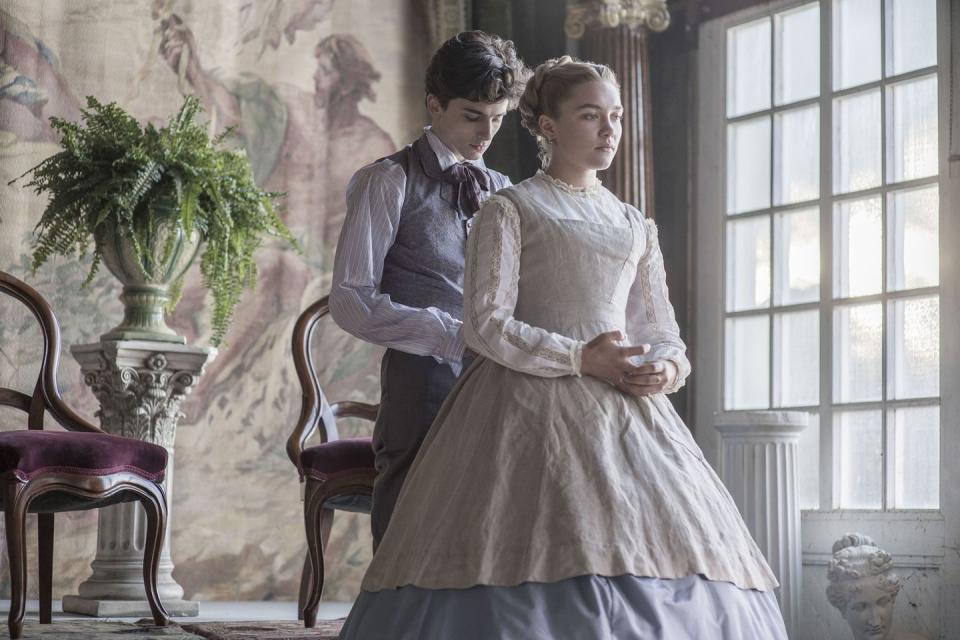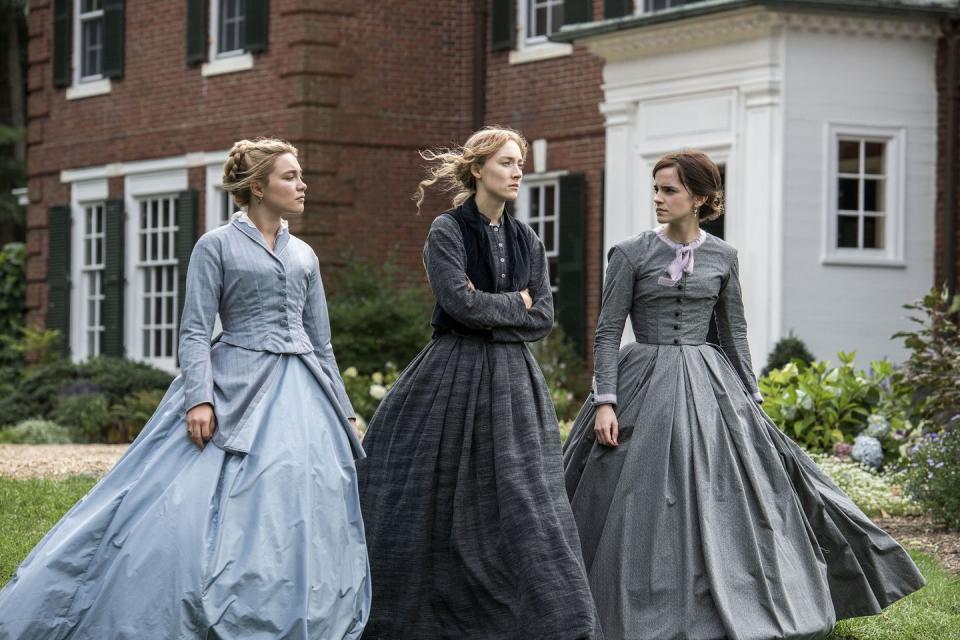Jo and Laurie Shared Clothes on Purpose in 'Little Women'

Greta Gerwig’s Little Women hit a nerve because of its refreshing screenplay, the palpable chemistry among the cast, and impeccable performances from stars like Saoirse Ronan and Florence Pugh. But the clothes added to the magic in ways viewers might not have noticed while watching. While period dramas run the risk of using stiff and stuffy fashion, costume designer Jacqueline Durran gave this 1860s-set story heart and authenticity by carefully curating wardrobes that honor each person and reusing the same pieces to emphasize onscreen relationships.
“If you start from the roots of the character each time, for each individual, then that's the touchstone of it," Durran tells BAZAAR.com of her process for dressing each March sister. "In the end, it just comes down to how you perceive it. You make design choices for each person as you go along, and you say, well, ‘That's so Jo,’ or ‘That's very Meg.’ But it's an idea that you've evolved from looking at research and thinking about the characters and having fittings. And then, it all becomes—hopefully—quite clear.”
Indeed, Jo (Ronan) frequents vests to reflect her tomboyish side, Amy (Pugh) wears luxurious gowns in Paris, Meg (Emma Watson) lears to embrace practical apparel, and Beth (Eliza Scanlen) gravitates to softer colors. But no wardrobe was static; pieces were frequently shared among characters to add backstory. In real life, you share clothes with your sisters, your best friends, and your mom—so that’s exactly what the Marches did. Jo swaps waistcoats with her childhood friend Theodore “Laurie” Laurence (Timothée Chalamet), Marmee (Laura Dern) borrows pieces from her daughters, and Jo wears some of Beth’s clothing after she dies.
The shared wardrobes underline how close the bonds were, especially between Laurie and Jo, who shared a certain waistcoat that pulled at the Internet's heartstrings. During one scene in their childhood, Laurie wears a gold and red spotted vest when Jo playfully gives him a ring. Later on, Jo wears the same vest when Laurie professes his love for her (and she turns him down).
jo wore laurie’s vest in THAT scene we had to cry pic.twitter.com/kfyY3xzvjb
— diana (@tchalemet) December 26, 2019
“What we were trying to achieve was to emphasize a back and forth of fluidity between the two of them in a way that they were just best friends, and they identified with each other, and they wanted to be the other person, and they shared clothes,” Durran explains. The mutual wardrobe also showed how Jo’s boyish side was "part of her friendship with Laurie.”
Here, Duran, who is nominated for a costume design Oscar this year, shares more details from her work on Little Women.
Durran plotted out the exact moments Jo and Laurie shared clothes.
“You do plan it,” she says. “Because that's about their proximity as well. That's about their closeness. And the proposal is the crux point of that.”
Durran says it was “quite hard” figuring out what was going to be worn and where, but she decided that the red and gold waistcoat would be established on Laurie first so viewers would later recognize it on Jo. In that case, Chalamet and Ronan shared one vest, but in other scenes, two different pieces were made to accommodate each actor’s measurements. The duo also shared another vest and a jacket too.
“Even though they were approximately the same size, Timothée's so much taller than Saoirse that it's actually better to have one with a longer body on a shorter body,” Durran explains.
Clothes were in heavy rotation within the March family.
“The other clothes sharing was Marmee wearing things from Jo, Beth wearing things from Jo, and then, Jo wearing things from Beth. Everybody used the same shawls and things because they were just things that would have just been in the house. Someone would need it and then another person would use it,” Durran says.
While she didn’t really plot out what clothes Marmee would be borrowing, she did plan when Jo and Beth would exchange pieces. “Beth wears Jo's clothes when they go to the seaside and she's sick. And then, after Beth has died, Jo wears Beth's clothes. And that's because she wants the closeness to Beth after she's gone,” Durran says. Jo even wears Beth’s aubergine jacket with a velvet cusp after the younger sibling passes.

The color of Jo’s “writing jacket” was carefully chosen.
Towards the end of the film, Jo slips on a deep green velvet military jacket when she writes her novel. Durran and her team made the piece, using 19th century military fashion as inspiration. But considering the story is set during the Civil War, when most uniforms were red or blue, they chose to make the coat an apolitical green. They copied the gold braids used on real uniforms but scuffed it up. “Because we wanted it to appear like an old jacket that somehow had turned up in the theatrical clothes in the house or somehow had ended up at the March house, we aged it and broke the braid and made it look really old and tacky," Durran reveals.
Jo actually wears the coat early in the film, after waking up for Christmas morning with her sisters, but we see it most during her writing process. Even Ronan connected with it. “Saoirse was the one who said that the military jacket really worked conceptually for her, because she felt it was something you'd put on when you wanted to achieve [something]. When she wanted to write, it sort of represented that for her,” Durran says.

Jo’s vests were based on the fashion of the time.
“It was true to the period. There are women's Victorian waistcoats. It wasn't a total fantasy. Obviously, when she was young when she was wearing Laurie's. But when she was older, she had slightly more fitted, still slightly boyish, waistcoats, and that was just her thing, her look. That was part of the continuity that lets you know who she is.”
Chalamet helped choose his own looks.
"I looked at his costume in his trailer in the morning and then, when he was ready to dress, I'd go and see him," Durran says. "We would talk about how he was going to wear those pieces. I gave him those kind of Victorian pieces and he decided which things and in which way he was going to wear them."
The costume designer also did that to a lesser extent with the other actors so they really connected to their clothes. "I really wanted them to wear them in a way that they felt expressed their character," she says.

Developing each sister’s wardrobe was a hard and careful process.
“It's very difficult to explain that because, really, what you do is you start off looking for research that expresses each of those characters. And then your mind's just started to make groupings of styles and things that you feel are representative of each character. You start to be able to identify what each character would be. You sort of get used to the idea of it," Durran says.
She collected a range of costumes then held fittings. She also paid attention to the acting in each scene. "You see how people respond to them and what suits them and how the whole thing hangs together," she says. "And then, that's how you create a wardrobe."
Each sister also has a vague color palette, Durran points out. Jo has red and blue, Meg has lavender and green, Beth has pink and brown, and Amy has light blue. “It's not like I slavishly only dress them in that. It's just that that's thematically run through their clothes,” she adds.

There were separate wardrobes for childhood and adulthood.
Considering Gerwig’s take on Little Women frequently switched between the past and present, the March sisters had two separate wardrobes to denote the passage of time. Meg’s (Emma Watson) transformation was the least drastic, “because she was already quite grown-up when she was a child,” Durran says. But her younger wardrobe has more “fairytale," Gothic revival detailing, but when she grows up, she leaves that behind, which parallels her storyline: She lets go of frivolous things and is forced to become thrifty. For Beth, it was the reverse. “Beth doesn't really grow up,” Durran says.
“Amy changes the complete most, because she starts as the youngest and then becomes the most sophisticated. She starts in very much Victorian children's clothes. And then, she jumps right through to those fashionable clothes of the 1860s, 1870s,” Durran explains.
Jo was supposed to wear a hooped skirt whens he moves to New York to look “respectable and conventional” and create a stronger contrast to her childhood look, but it "just didn't feel right," Durran continues.
“So, we reverted back to having a longer skirt but without hoops. And then, it felt like a progression of the same character rather than too big a jump.”

Gerwig helped Durran get a feel for what each character would dress like.
Durran wasn't obsessed with Little Women growing up. She read the book but didn't watch the 1994 film, so she came to Gerwig's project with fresh eyes. The director wanted the costumes to "capture the spirit of the family and the girls and the life of the whole scene," Durran recalls.
"She specifically came to London and spent time going through references with me and picking out things that looked like Meg or looked like Jo from the original photography," she adds. "She did that process with me. And then, it was really just about capturing the spirit that she wanted in the film.”
You Might Also Like

